belt Citroen C5 2016 (RD/TD) / 2.G User Guide
[x] Cancel search | Manufacturer: CITROEN, Model Year: 2016, Model line: C5, Model: Citroen C5 2016 (RD/TD) / 2.GPages: 366, PDF Size: 30.93 MB
Page 159 of 366

157
C5_en_Chap06_securite_ed01-2015
Airbags
System designed to contribute towards
improving the safety of the occupants (with
the exception of the rear centre passenger)
in the event of a violent collision. The airbags
supplement the action of the force-limiting
seat belts.
If a collision occurs, the electronic detectors
record and analyse the front and side impacts
sustained in the impact detection zones:
- in the case of a serious impact, the airbags
are deployed instantly and contribute
towards best protecting the occupants of
the vehicle (with the exception of the rear
centre passenger); immediately after the
impact, the airbags deflate rapidly so that
they do not hinder visibility or the exit of the
occupants,
- in the case of a minor or rear impact or in
certain roll-over conditions, the airbags
may not be deployed; the seat belt alone
contributes towards your protection in
these situations.
Impact detection zones
A. Front impact zone.
B. Side impact zone.
The airbags do not operate when
the ignition is switched off.
This equipment will only deploy once.
If a second impact occurs (during
the same or a subsequent accident),
the deployment of airbag will not be
triggered again. Deployment of one or more airbags
is accompanied by a slight emission
of smoke and a noise, due to the
activation of the pyrotechnic cartridge
incorporated in the system.
This smoke is not harmful, but sensitive
individuals may experience slight
irritation.
The noise of the detonation related to
the deployment of one or more airbags
may result in a slight loss of hearing for
a short time.
6
Safety
Page 163 of 366
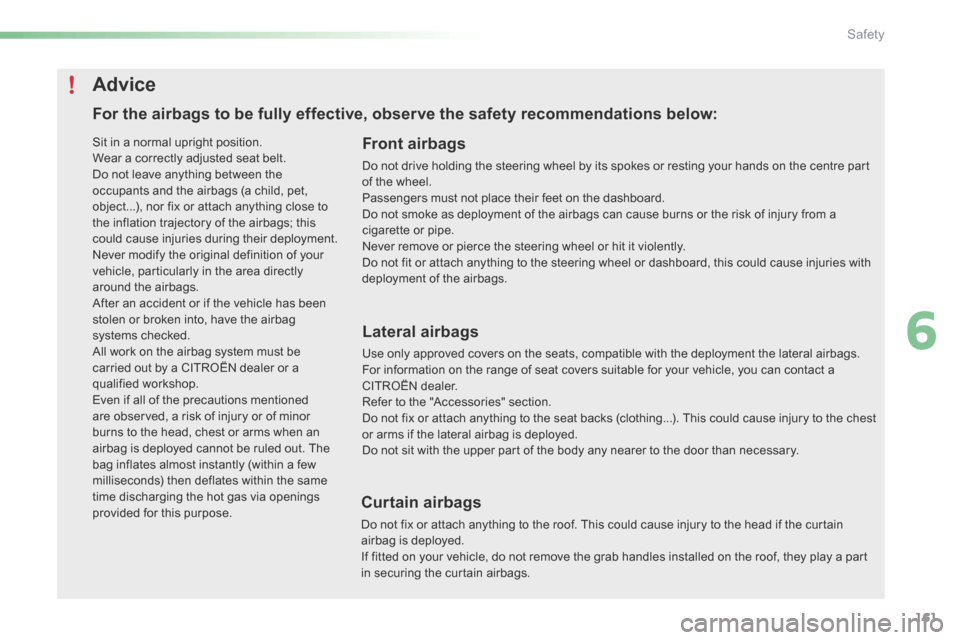
161
C5_en_Chap06_securite_ed01-2015
For the airbags to be fully effective, observe the safety recommendations below:Front airbags
Do not drive holding the steering wheel by its spokes or resting your hands on the centre part
of the wheel.
Passengers must not place their feet on the dashboard.
Do not smoke as deployment of the airbags can cause burns or the risk of injury from a
cigarette or pipe.
Never remove or pierce the steering wheel or hit it violently.
Do not fit or attach anything to the steering wheel or dashboard, this could cause injuries with
deployment of the airbags.
Lateral airbags
Use only approved covers on the seats, compatible with the deployment the lateral airbags.
For information on the range of seat covers suitable for your vehicle, you can contact a
CITROËN dealer.
Refer to the "Accessories" section.
Do not fix or attach anything to the seat backs (clothing...). This could cause injury to the chest
or arms if the lateral airbag is deployed.
Do not sit with the upper part of the body any nearer to the door than necessary.
Curtain airbags
Do not fix or attach anything to the roof. This could cause injury to the head if the curtain
airbag is deployed.
If fitted on your vehicle, do not remove the grab handles installed on the roof, they play a part
in securing the curtain airbags.
Advice
Sit in a normal upright position.
Wear a correctly adjusted seat belt.
Do not leave anything between the
occupants and the airbags (a child, pet,
object...), nor fix or attach anything close to
the inflation trajectory of the airbags; this
could cause injuries during their deployment.
Never modify the original definition of your
vehicle, particularly in the area directly
around the airbags.
after an accident or if the vehicle has been
stolen or broken into, have the airbag
systems checked.
All work on the airbag system must be
carried out by a CITR oËn dealer or a
qualified workshop.
Even if all of the precautions mentioned
are observed, a risk of injury or of minor
burns to the head, chest or arms when an
airbag is deployed cannot be ruled out. The
bag inflates almost instantly (within a few
milliseconds) then deflates within the same
time discharging the hot gas via openings
provided for this purpose.
6
Safety
Page 164 of 366
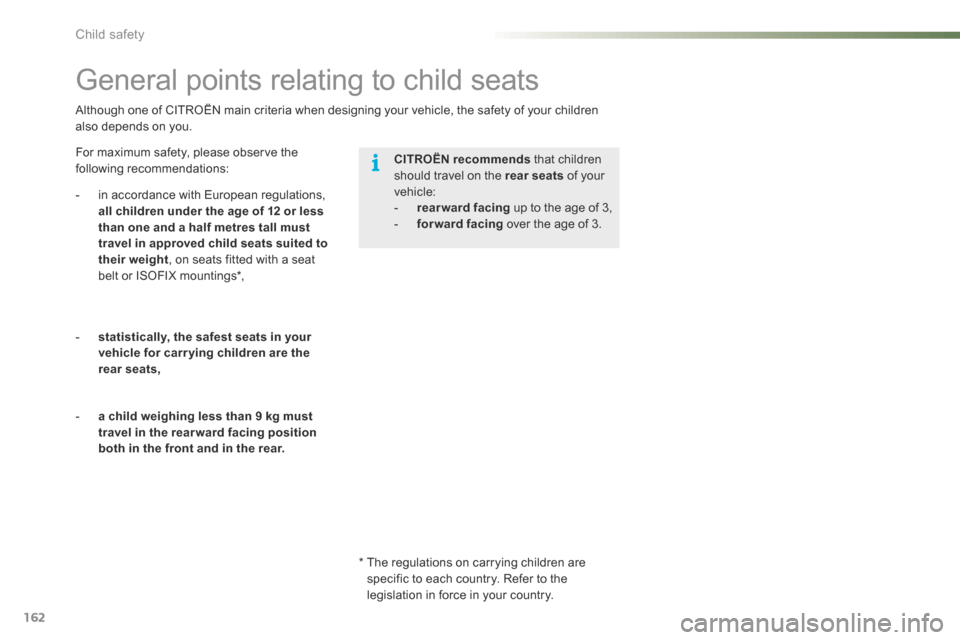
162
C5_en_Chap07_securite-enfant_ed01-2015
Although one of CITROËN main criteria when designing your vehicle, the safety of your children
also depends on you.
General points relating to child seats
For maximum safety, please observe the
following recommendations:* The regulations on carrying children are
specific to each country. Refer to the
legislation in force in your country. CITROËN recommends
that children
should travel on the rear seats of your
vehicle:
- rearward facing up to the age of 3,
- forward facing over the age of 3.
-
in accordance with European regulations,
all children under the age of 12 or less
than one and a half metres tall must
travel in approved child seats suited to
their weight , on seats fitted with a seat
belt or ISOFIX mountings*,
- statistically, the safest seats in your
vehicle for carr ying children are the
rear seats,
- a child weighing less than 9 kg must
travel in the rear ward facing position
both in the front and in the rear.
Child safety
Page 165 of 366
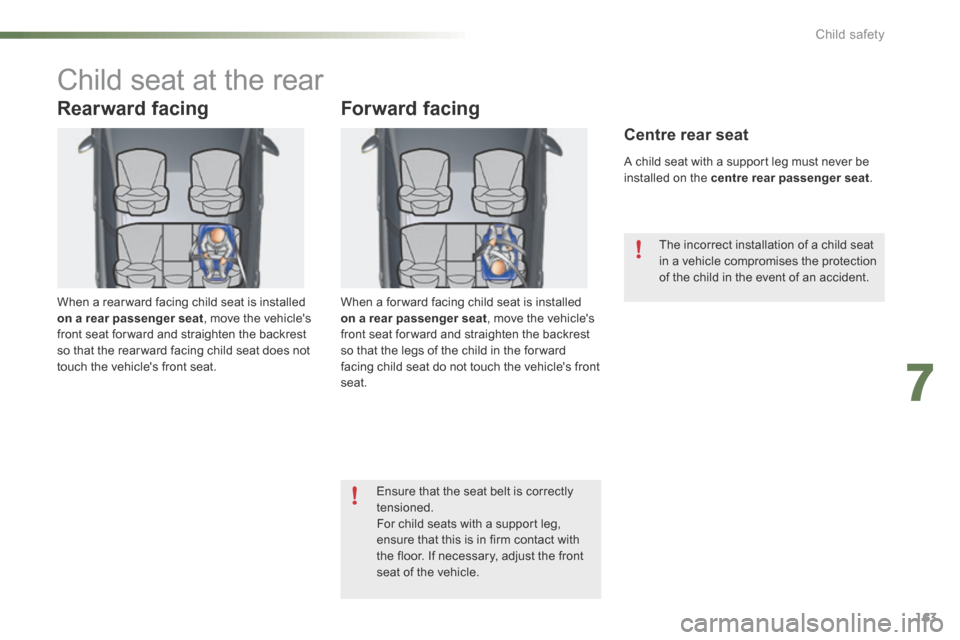
163
C5_en_Chap07_securite-enfant_ed01-2015
Child seat at the rear
Rearward facing
When a rear ward facing child seat is installed
on a rear passenger seat, move the vehicle's
front seat for ward and straighten the backrest
so that the rear ward facing child seat does not
touch the vehicle's front seat.
Forward facing
When a for ward facing child seat is installed
on a rear passenger seat , move the vehicle's
front seat for ward and straighten the backrest
so that the legs of the child in the for ward
facing child seat do not touch the vehicle's front
seat.
Centre rear seat
A child seat with a support leg must never be
installed on the centre rear passenger seat .
Ensure that the seat belt is correctly
tensioned.
For child seats with a support leg,
ensure that this is in firm contact with
the floor. If necessary, adjust the front
seat of the vehicle. The incorrect installation of a child seat
in a vehicle compromises the protection
of the child in the event of an accident.
7
Child safety
Page 166 of 366
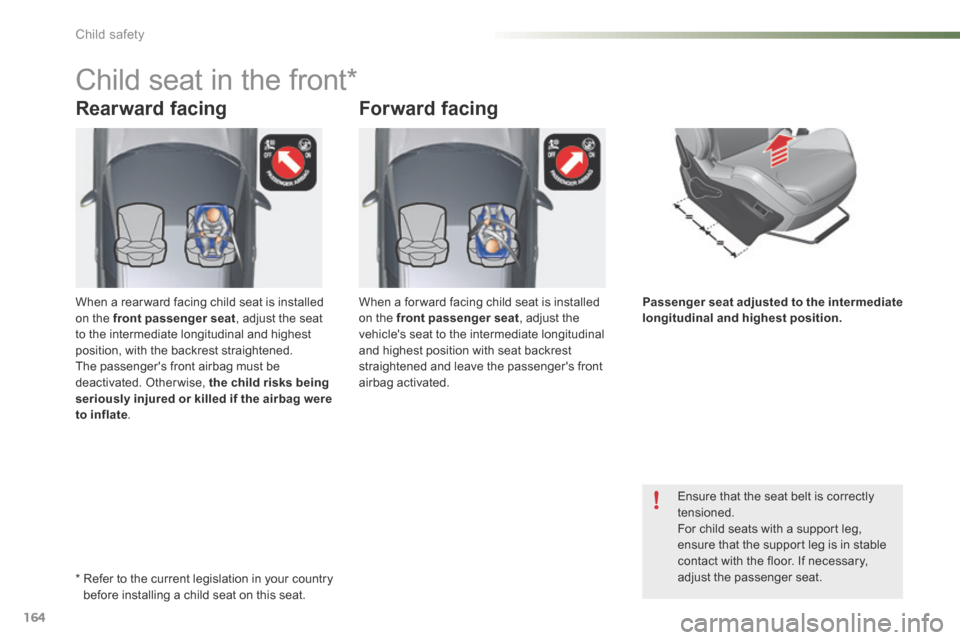
164
C5_en_Chap07_securite-enfant_ed01-2015
Rearward facingForward facing
Child seat in the front*
Ensure that the seat belt is correctly
tensioned.
For child seats with a support leg,
ensure that the support leg is in stable
contact with the floor. If necessary,
adjust the passenger seat.
* Refer to the current legislation in your country
before installing a child seat on this seat.
When a rear ward facing child seat is installed
on the front passenger seat
, adjust the seat
to the intermediate longitudinal and highest
position, with the backrest straightened.
The passenger's front airbag must be
deactivated. Otherwise, the child risks being
seriously injured or killed if the airbag were
to inflate . When a for ward facing child seat is installed
on the front passenger seat
, adjust the
vehicle's seat to the intermediate longitudinal
and highest position with seat backrest
straightened and leave the passenger's front
airbag activated. Passenger seat adjusted to the intermediate
longitudinal and highest position.
Child safety
Page 170 of 366
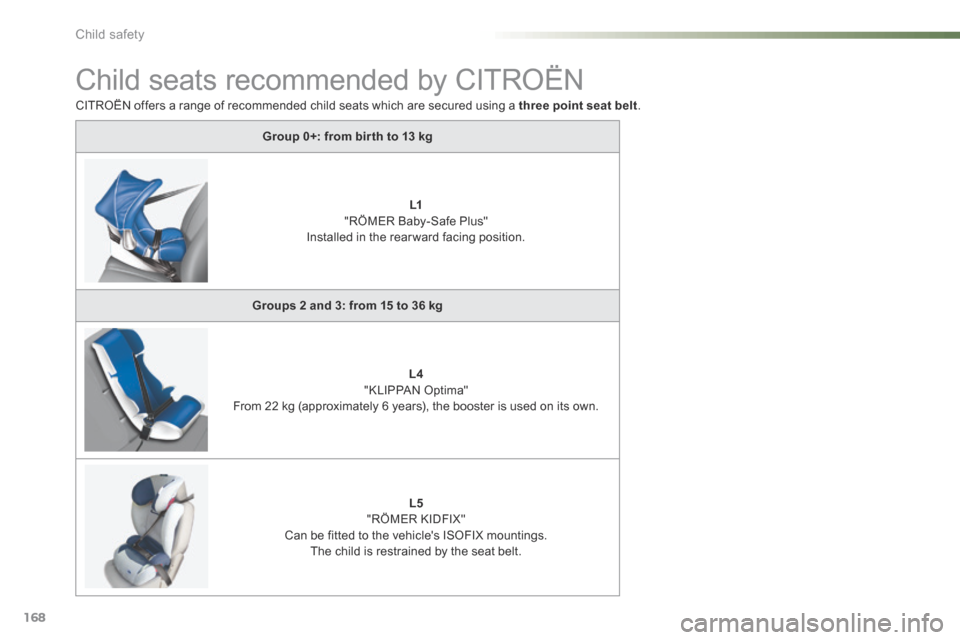
168
C5_en_Chap07_securite-enfant_ed01-2015
Child seats recommended by CITROËN
Group 0+: from bir th to 13 kgL1
"RÖMER b aby-Safe Plus"
Installed in the rear ward facing position.
Groups 2 and 3: from 15 to 36 kg L4
"KLIPPAN Optima"
From 22 kg (approximately 6 years), the booster is used on its own.
L5
"RÖMER kIdFIX"
Can be fitted to the vehicle's ISOFIX mountings. The child is restrained by the seat belt.
CITROËN offers a range of recommended child seats which are secured using a three point seat belt
.
Child safety
Page 171 of 366
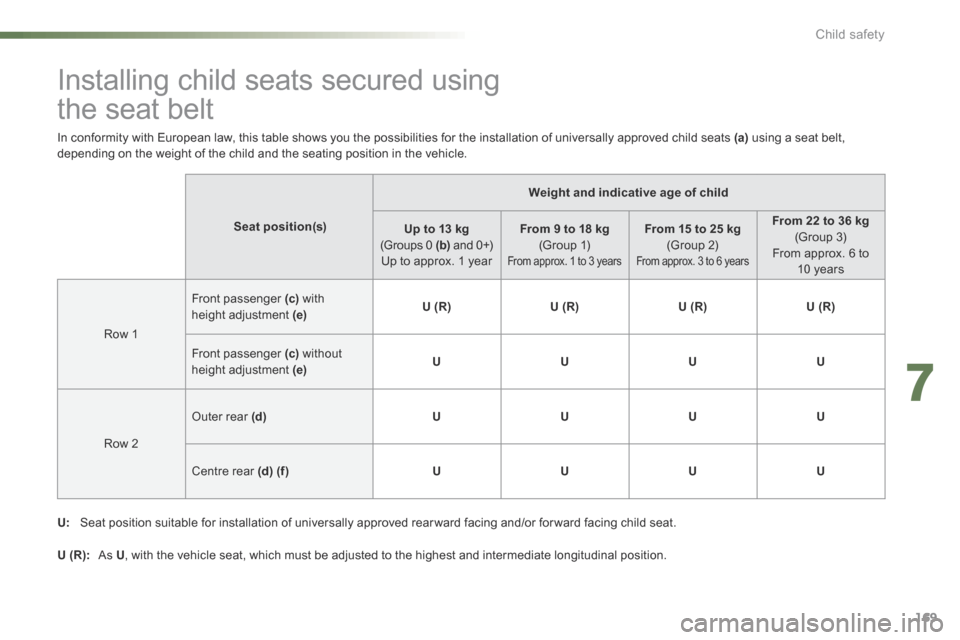
169
C5_en_Chap07_securite-enfant_ed01-2015
Installing child seats secured using
the seat belt
Seat position(s)Weight and indicative age of child
Up to 13 kg
(Groups 0 (b) and 0+)
Up to approx. 1 year From 9 to 18 kg
(Group 1)
From approx. 1 to 3 years
From 15 to 25 kg (Group 2)
From approx. 3 to 6 years
From 22 to 36 kg (Group 3)
From approx. 6 to 10 years
Row 1 Front passenger
(c) with
height adjustment (e) U (R)
U (R)U (R)U (R)
Front passenger (c) without
height adjustment (e) U
UUU
Row 2 o
uter rear (d) UUUU
Centre rear (d) (f ) UUUU
In conformity with European law, this table shows you the possibilities for the installation of universally approved child seats (a)
using a seat belt,
depending on the weight of the child and the seating position in the vehicle.
U: Seat position suitable for installation of universally approved rear ward facing and/or for ward facing child seat.
U (R): as U, with the vehicle seat, which must be adjusted to the highest and intermediate longitudinal position.
7
Child safety
Page 172 of 366

170
C5_en_Chap07_securite-enfant_ed01-2015
(a) Universal child seat: child seat which can
be installed in all vehicles using the seat
belt.
( b ) Group 0: from birth to 10 kg. Shells and
"car cots" cannot be installed on the front
passenger seat.
( c ) Consult the current legislation for your
country before driving with your child in this
seat.
(d) To install a child seat on a rear seat,
rear ward facing or for ward facing, move
the front seat for ward, then straighten the
backrest to allow enough space for the
child seat and the child's legs. Remove and stow the head restraint
before installing a child seat with a
backrest on a passenger seat. Refit the
head restraint once the child seat has
been removed.
(e)
When a rear ward facing child seat is
installed on the front passenger seat , the
passenger airbag must be deactivated.
o therwise the child would risk being
seriously injured or killed if the
airbag were deployed . When a for ward
facing child seat is installed on the front
passenger seat , the passenger airbag
must remain active.
(f ) A child seat with a support leg must never
be installed on the centre rear seat .
Child safety
Page 173 of 366
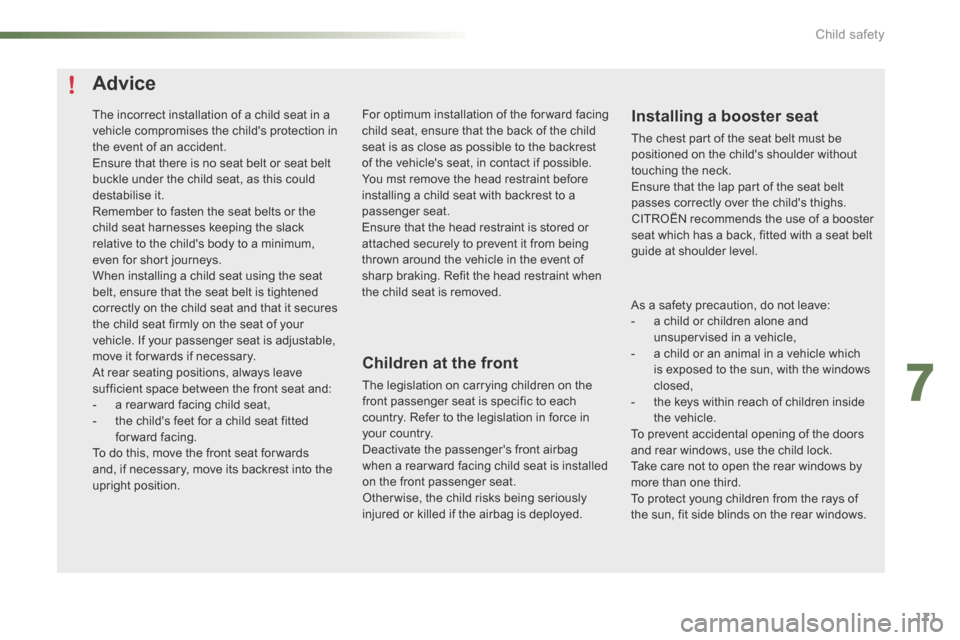
171
C5_en_Chap07_securite-enfant_ed01-2015
Advice
Children at the front
The legislation on carrying children on the
front passenger seat is specific to each
country. Refer to the legislation in force in
your country.
Deactivate the passenger's front airbag
when a rear ward facing child seat is installed
on the front passenger seat.
Otherwise, the child risks being seriously
injured or killed if the airbag is deployed.
Installing a booster seat
The chest part of the seat belt must be
positioned on the child's shoulder without
touching the neck.
Ensure that the lap part of the seat belt
passes correctly over the child's thighs.
CITROËN recommends the use of a booster
seat which has a back, fitted with a seat belt
guide at shoulder level.
The incorrect installation of a child seat in a
vehicle compromises the child's protection in
the event of an accident.
Ensure that there is no seat belt or seat belt
buckle under the child seat, as this could
destabilise it.
Remember to fasten the seat belts or the
child seat harnesses keeping the slack
relative to the child's body to a minimum,
even for short journeys.
When installing a child seat using the seat
belt, ensure that the seat belt is tightened
correctly on the child seat and that it secures
the child seat firmly on the seat of your
vehicle. If your passenger seat is adjustable,
move it for wards if necessary.
At rear seating positions, always leave
sufficient space between the front seat and:
-
a rear ward facing child seat,
- the child's feet for a child seat fitted
forward facing.
To do this, move the front seat for wards
and, if necessary, move its backrest into the
upright position. For optimum installation of the forward facing
child seat, ensure that the back of the child
seat is as close as possible to the backrest
of the vehicle's seat, in contact if possible.
You mst remove the head restraint before
installing a child seat with backrest to a
passenger seat.
Ensure that the head restraint is stored or
attached securely to prevent it from being
thrown around the vehicle in the event of
sharp braking. Refit the head restraint when
the child seat is removed.
As a safety precaution, do not leave:
- a child or children alone and
unsupervised in a vehicle,
- a child or an animal in a vehicle which
is exposed to the sun, with the windows
closed,
- the keys within reach of children inside
the vehicle.
To prevent accidental opening of the doors
and rear windows, use the child lock.
Take care not to open the rear windows by
more than one third.
To protect young children from the rays of
the sun, fit side blinds on the rear windows.
7
Child safety
Page 176 of 366
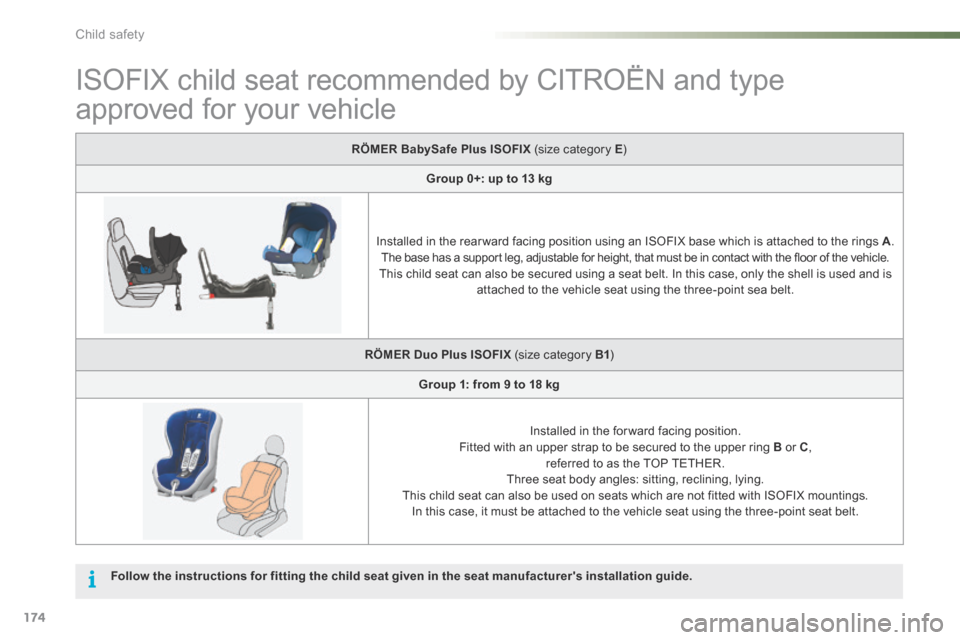
174
C5_en_Chap07_securite-enfant_ed01-2015
ISOFIX child seat recommended by CITROËN and type
approved for your vehicle
RÖMER BabySafe Plus ISOFIX (size category E)
Group 0+: up to 13 kg
Installed in the rear ward facing position using an ISOFIX base which is attached to the rings A .
The base has a support leg, adjustable for height, that must be in contact with the floor of the vehicle.
This child seat can also be secured using a seat belt. In this case, only the shell is used and is attached to the vehicle seat using the three-point sea belt.
RÖMER Duo Plus ISOFIX (size category B1 )
Group 1: from 9 to 18 kg
Installed in the for ward facing position.
Fitted with an upper strap to be secured to the upper ring B or C ,
referred to as the TOP TETHER.
Three seat body angles: sitting, reclining, lying.
This child seat can also be used on seats which are not fitted with ISOFIX mountings. In this case, it must be attached to the vehicle seat using the three-point seat belt.
Follow the instructions for fitting the child seat given in the seat manufacturer's installation guide.
Child safety